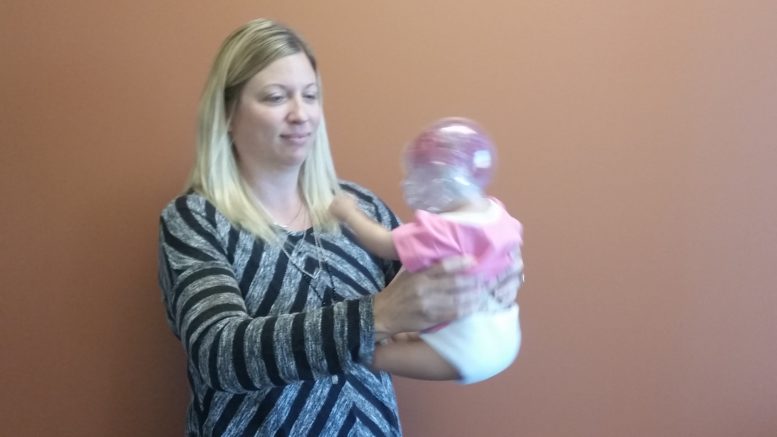By JAN LARSON McLAUGHLIN
BG Independent News
Sometimes there is just no soothing a crying baby. Nothing works. Not rocking. Not feeding. Not a midnight car ride. Nothing.
When you can no longer remain calm, the experts advise that you walk away.
“Babies don’t die from crying. Put them in a safe place,” and then leave the room, advised Brandy Laux, assessment supervisor with Wood County Children’s Services. Call a responsible friend or family member for help.
Never let your frustration reach the level that you shake the baby.
“One time of shaking can be fatal,” Laux explained.
To help prospective and new parents understand the risks of shaking babies, Children’s Services has adopted a new baby that shows how easy it is to damage a baby’s brain by shaking. Depending on how hard the doll is shaken, areas of the head light up to show where damage could occur. The red lights show if the shaking is affecting the baby’s vision, speech, cognitive thinking, or control of arms and legs.
“Their heads move much more easily than ours,” Sandi Carsey, director of Children’s Services, said about infants who haven’t yet developed neck control. “Places will light up in the brain and eyes. This will show what part of the brain was damaged.”
Children’s Services is trying to reach out to parents before it’s too late.
“The people who shake a baby aren’t your violent criminals,” Laux said. “It’s the people who flip out of frustration.”
The doll will be used in demonstrations to new parents at the hospital and to high school students. “Those kids are future parents and they babysit,” Carsey said.
It’s not uncommon for some infants to cry for five to seven hours a day, according to Laux. And it often has nothing to do with the parenting.
“Don’t be afraid of your baby crying,” Laux said. “It’s normal, but obviously frustrating.”
Previously, the shaken baby syndrome lesson was taught using an egg cracked into a Rubbermaid container. If the container is dropped or rolled off furniture, the yolk consistently remains intact. But if shaken, it breaks.
The frequency of shaken baby syndrome cases varies in Wood County. Last year there was one. But in a previous year, there were three in a six-week period, Carsey said.
“We’ll go a period of time when we don’t have any, thankfully,” she said.
The new “baby” is expected to be a more effective educational tool, since it comes with a realistic cry.
“If you really shake it, it stops the baby from crying because of the damage to the brain,” Laux said.
“Most of the excuses we get with shaken babies is that they fell off the bed” or rolled off the couch, Laux said. However, dropping the baby model on the floor doesn’t cause any of the lights in the head to turn on.
“It just shows how angry people are” when they shake an infant, Carsey said. “Most of the time people are so mad they don’t realize how hard they are doing it.”
Following is some information Children’s Services gives to parents.
What’s all the crying about:
– Babies cry more in the evening
– There may be no obvious cause for the crying
– Crying can last hours at a time
– Soothing a baby may not stop the crying
Suggestions to calm a baby:
– Carry the baby while walking around
– Give baby a warm bath
– Lay baby tummy-down across your lap and gently pat his back
– Run the vacuum cleaner
– Give baby something new to look at or hold
– Take baby outside for a walk
– Take the baby for a ride in a car
– Sing to baby
– Hold baby close to your skin
How to keep yourself calm:
– Find a patient and responsible friend or family member to give you a break
– Place baby in a safe place and walk away for a while
– Make time to take a walk or exercise
– Sleep then the baby sleeps
Activities that don’t cause Shaken Baby Syndrome:
– Bouncing baby on knee
– Tossing baby in the air
– Running or cycling with baby
– Falling off furniture
– Sudden stops in car
Common symptoms of Shaken Baby Syndrome:
– Seizures
– Not as alert
– Decreased appetite
– Problems sucking or swallowing
– Excessive sleepiness
– Problems breathing
– Vomiting

